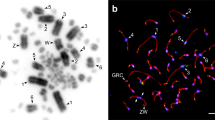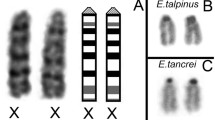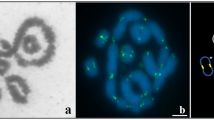Abstract
In the zebra finch (Taeniopygia guttata), there is a germ-line-restricted chromosome regularly present in males and females. A reexamination of male and female meiosis in the zebra finch showed that this element forms a euchromatic bivalent in oocytes, but it is always a single, heterochromatic element in spermatocytes. Immunostaining with anti-MLH1 showed that the bivalent in oocytes has two or three foci with a localized pattern, indicating the regular occurrence of recombination. In male meiosis, the single restricted chromosome forms an axis that contains the cohesin subunit SMC3, and the associated chromatin is densely packed until late pachytene. Electron microscopy of thin-sectioned seminiferous tubules shows that the restricted chromosome is eliminated in postmeiotic stages in the form of packed chromatin inside a micronucleus, visible in the cytoplasm of young spermatids. The selective condensation of the restricted chromosome during early meiotic prophase in males is interpreted as a strategy to avoid the triggering of asynaptic checkpoints, but this condensation is reversed prior to the final condensation that leads to its (ulterior) elimination. Recombination during female meiosis may prevent the genetic attrition of the restricted chromosome and, along with the elimination in male germ cells, ensures its regular transmission through females.





Similar content being viewed by others
References
Anderson LK, Reeves A, Webb LM, Ashley T (1999) Distribution of crossing over on mouse synaptonemal complexes using immunofluorescent localization of MLH1 protein. Genetcis 151:1569–1579
Baker SM, Plug AW, Prolla TA, Bronner CE, Harris AC, Yao X, Christie DM, Monell C, Arnheim N, Bradley A, Ashley T, Liskay RM (1996) Involvement of mouse Mlh1 in DNA mismatch repair and meiotic crossing over. Nat Genet 13:336–342
Barlow AL, Hulten MA (1998) Crossing over analysis at pachytene in man. Eur J Hum Genet 6:350–358
Barton NH, Charlesworth B (1998) Why sex and recombination? Science 281:1986–1990
Catalan J, Autio K, Kuosma E, Norppa H (1998) Age-dependent inclusion of sex chromosomes in lymphocyte micronuclei of man. Am J Hum Genet 63:1464–1472
Christidis L (1986) Chromosomal evolution within the family Estrildidae (Aves). I. The Poephilae. Genetica 71:81–97
Cimini D, Fioravanti D, Salmon ED, Degrassi F (2002) Merotelic kinetochore orientation versus chromosome mono-orientation in the origin of lagging chromosomes in human primary cells. J Cell Sci 115:507–515
Eijpe M, Offenberg H, Jessberger R, Revenkova E, Heyting C (2003) Meiotic cohesin REC8 marks the axial elements of rat synaptonemal complexes before cohesins SMC1β and SMC3. J Cell Biol 160:657–670
Felsenstein J (1974) The evolutionary advantage of recombination. Genetics 78:737–756
Goday C, Esteban MR (2001) Chromosome elimination in sciarid flies. Bioessays 23:242–250
Haig J (1978) The accumulation of deleterious genes in a population—Muller's ratchet. Theor Popul Biol 14:251–267
Hayman DL, Martin PG (1974) Mammalia I: Monotremata and Marsupialia. In: John B (ed) Animal cytogenetics 4: Chordata. Gebrüder Borntraeger, Berlin
Hennig W (1986) Heterochromatin and germ line-restricted DNA. Results Probl Cell Differ 13:175–192
Itoh Y, Arnold AP (2005) Chromosomal polymorphism and comparative painting analysis in the zebra finch. Chromosome Res 13:47–56
Jessberger R (2002) The many functions of SMC proteins in chromosome dynamics. Nat Rev Mol Cell Biol 3:767–778
Jones RN, Rees H (1982) B chromosomes. Academic Press, London
Kloc M, Zagrodzinska B (2001) Chromatin elimination—an oddity or a common mechanism in differentiation and development? Differentiation 68:84–91
Kubota S, Takano J, Tsuneishi R, Kobayakawa S, Fujikawa N, Nabeyama M, Kohno S (2001) Highly repetitive DNA families restricted to germ cells in a Japanese hagfish (Eptatretus burgeri): a hierarchical and mosaic structure in eliminated chromosomes. Genetica 111:319–328
Nakai Y, Kubota S, Goto Y, Ishibashi T, Davison W, Kohno S (1995) Chromosome elimination in three Baltic, south Pacific and north-east Pacific hagfish species. Chromosome Res 3:321–330
Nasmyth K (2001) Disseminating the genome: joining, resolving, and separating sister chromatids during mitosis and meiosis. Annu Rev Genet 35:673–745
Nicklas RB (1997) How cells get the right chromosomes. Science 275:632–637
Ohno S (1967) Sex chromosomes and sex-linked genes. Springer, Berlin Heidelberg New York
Pigozzi MI (2001) Distribution of MLH1 foci on the synaptonemal complexes of chicken oocytes. Cytogenet Cell Genet 95:129–133
Pigozzi MI, Solari AJ (1998) Germ cell restriction and regular transmission of an accessory chromosome that mimics a sex body in the zebra finch, Taeniopygia guttata. Chromosome Res 6:105–113
Pimpinelli S, Goday C (1989) Unusual kinetochores and chromatin diminution in Parascaris. Trends Genet 5:310–315
Rice WR, Chippindale AK (2001) Sexual recombination and the power of natural selection. Science 294:555–559
Roeder GS, Bailis JM (2000) The pachytene checkpoint. Trends Genet 16:395–403
Solari AJ (1977) Ultrastructure of the synaptic autosomes and the ZW bivalent in chicken oocytes. Chromosoma 64:155–165
Solari AJ (1998) Structural analysis of meiotic chromosomes and synaptonemal complexes in higher vertebrates. In: Berrios M (ed) Nuclear structure and function. Academic, New York, pp 236–256
Staiber W, Schiffkowski C (2000) Structural evolution of the germ line-limited chromosomes in Acricotopus. Chromosoma 109:343–349
Staiber W, Wech I, Preiss A (1997) Isolation and chromosomal localization of a germ line-specific highly repetitive DNA family in Acricotopus lucidus (Diptera, Chironomidae). Chromosoma 106:267–275
Takagi N (1972) A comparative study of the chromatin replication in 6 species of birds. Jap J Genetics 47:115–123
Tarsounas M, Moens PB (2001) Checkpoint and DNA-repair proteins are associated with the cores of mammalian meiotic chromosomes. Curr Top Dev Biol 51:109–134
Tiersch TR, Wachtel SS (1991) On the evolution of genome size in birds. J Hered 82:363–368
White MJD (1973) Animal cytology and evolution. Cambridge University Press, Cambridge, UK
Acknowledgements
The kind gifts of anti-SCP3 from P. Moens and CREST serum from W. Brinkley are gratefully acknowledged. The able technical help of C. Deparci is thanked. This work was supported by grants from the National Research Council (CONICET) and National Agency for Science and Technology. AJS and MIP are researchers from CONICET.
Author information
Authors and Affiliations
Corresponding author
Additional information
Communicated by P. Moens
Rights and permissions
About this article
Cite this article
Pigozzi, M.I., Solari, A.J. The germ-line-restricted chromosome in the zebra finch: recombination in females and elimination in males. Chromosoma 114, 403–409 (2005). https://doi.org/10.1007/s00412-005-0025-5
Received:
Revised:
Accepted:
Published:
Issue Date:
DOI: https://doi.org/10.1007/s00412-005-0025-5




